Day 2 of a three day Late Autumn / Early Winter Tour. It was a much nicer day today, dry with much lighter winds, and even some sunny moments in the afternoon. We spent the day on the coast between Holkham and Stiffkey.
With some new members of the group joining us this morning, we stopped again just on the outskirts of Wells first thing. There was no sign of the Rough-legged Buzzard at first – the raptors were mostly sitting around this morning, and it felt a bit cooler than yesterday. A Red Kite was perched up in a tree by the old railway cutting and a Common Buzzard was down in the long grass on the edge of one of the fields. A Kestrel landed in the bushes just in front of us.
There were quite a few Golden Plovers and Lapwings in the wetter fields again, and periodically they flew up and circled round. A Great White Egret flew over from the direction of Wells Harbour and we watched it disappear off towards Holkham. A small flock of Greylags was feeding in the cover crop showing off their carrot-like bills, with a Muntjac just behind them. There were several Grey Partridges in the field too but they were very hard to see in the vegetation unless they moved.
Two Fieldfares appeared in the top of a tree by one of the houses on the edge of Wells, behind us. A Bullfinch called from the thick hedge in front of us, and then flew out and past us. A Great Spotted Woodpecker then did exactly the same. There were lots of finches in the bushes, Chaffinches, Greenfinches and Goldfinches, and a few Linnets out in the field.
As the temperature started to increase so the raptors started to become more active. The Red Kite took off and flashed its forked tail as it circled, and several Common Buzzards came up now. The Marsh Harriers started to hunt too – we watched a distant dark male, then a paler male flying in along the bank. When the Marsh Harrier dinked down at the bank, we figured there must something there but we couldn’t see it, hidden by bushes in front of us. We walked just into the edge of the field to look round the brambles and realised it was the Rough-legged Buzzard!
It was perched in a bush half way down the bank, and we had a good view of the Rough-legged Buzzard through the scope. We could see the way its pale head contrasted with its dark, blackish belly. Eventually it took off, and we could see its pale tail with black terminal band as it flew up and over the bank and disappeared.
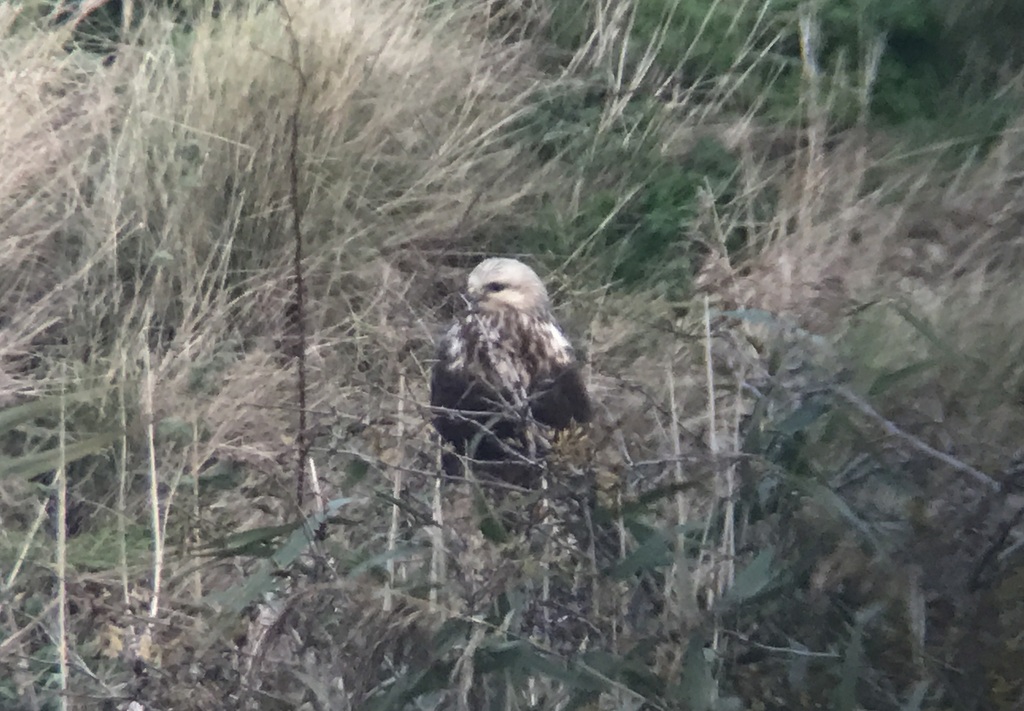
We decided to move on, and drove round to Holkham, where we parked at the top of Lady Anne’s Drive. After all the recent rain, there is a good amount of water now on the grazing marshes and there were lots of Wigeon and a couple of Shoveler around the edge of the pools. A small flock of Pied Wagtails and Meadow Pipits was feeding on the edge of the water just beyond the fence.
Four Grey Partridges flew across and landed just behind a gate back along the road, but ran back out into the middle as people approached. Further up, another larger covey of Grey Partridges was out in the middle of the marshes, well camouflaged among the clods of earth where the channels have been excavated recently.
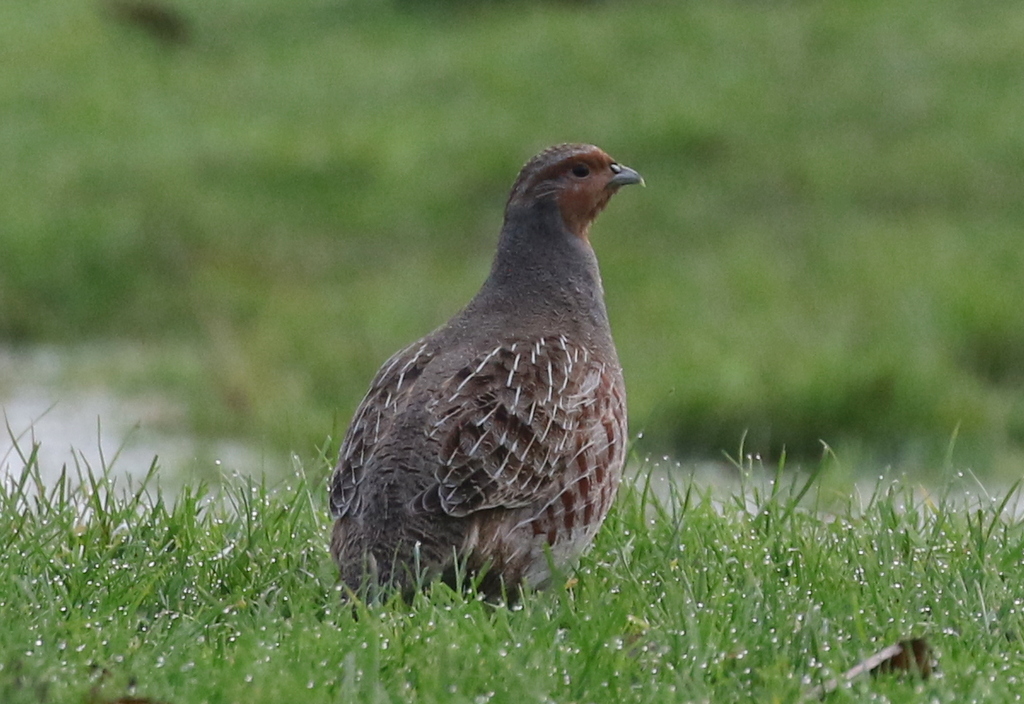
As we walked up towards the pines, there were a couple of Brent Geese and an Egyptian Goose out on the grazing marsh, and a Brown Hare too. Several skeins of Pink-footed Geese flew in and circled over the marshes calling. A few Jays back and forth in and out of the trees.
As we walked west along the path on the inland side of the pines, the trees were rather quiet today. Presumably most of the tits were feeding up in the pines. There were several Little Grebes on Salts Hole, along with a couple of Coot and a few Wigeon. We wanted to try to see the Hume’s Warbler which had taken up residence in the trees just beyond the crosstracks and, knowing we might need a little bit of time to pin it down, we pressed on west without stopping in the hides.
There were a few people looking for the Hume’s Warbler when we got there. It had been seen earlier but had disappeared into the bushes. A Chiffchaff was flitting around where it had been seen. Then we heard it call briefly from the back of the sallows. A tit flock came out – Long-tailed Tits, Blue, Great and Coal Tits too. There were one or two Goldcrests in the bushes. We got a glimpse of something small and pale which flew across, but we couldn’t find it again.
We walked round to the back of the sallows and met another couple of people who told us they had just been watching the Hume’s Warbler in one of the oak trees but it had now disappeared through the sallows. Back round the other side again, it reappeared, flying up out of the sallows and back up into the oak briefly. We could see it flitting around in the leaves but only a few of the group got onto it before it disappeared deeper into the tree.
It was a frustrating few minutes. We walked round to the back of the oaks but the Hume’s Warbler had now disappeared again. There was a shout to say it had been found, but there were just a couple of Goldcrests.
Then we heard it calling further back behind us. We hurried back round to where we had started and sure enough it had just reappeared. The Hume’s Warbler was flitting around in the tops of some sallows, against the light. Then it flew across the path to some thicker bushes. It seemed to have disappeared again, but then appeared on some brambles growing up between the sallows. Finally, we got a good view of it.
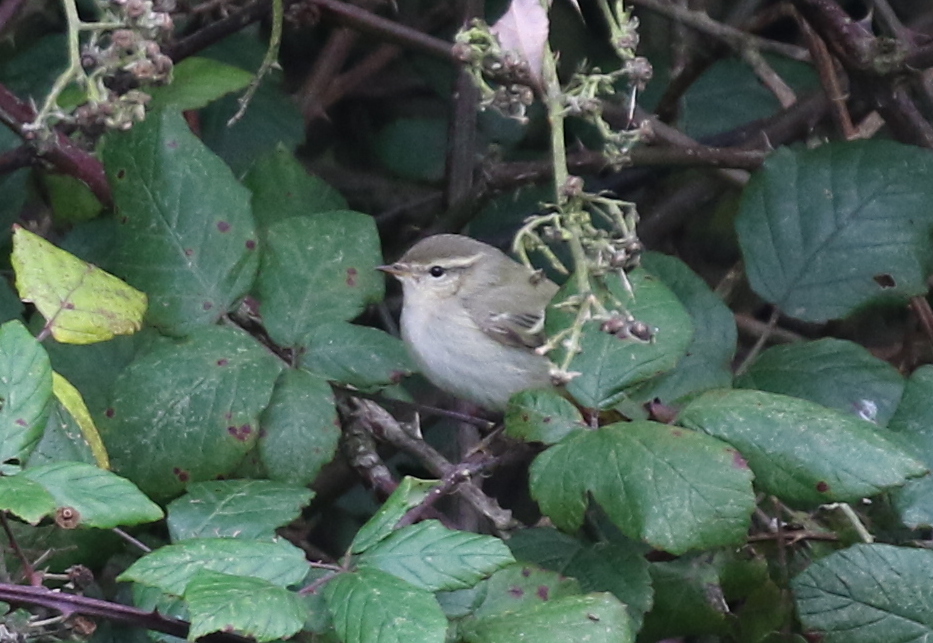
Hume’s Warbler is a rare visitor here, mostly in late autumn. They breed in the mountains of Central Asia and winter mostly in India, so this one was well off track. It seemed to flick off to the right and into the sallows, but when we looked back there was still a Hume’s Warbler in the brambles. Could there be two? We assumed we were just mistaken, but it turned out later that the Hume’s Warbler had indeed been joined by a second bird.
We made our way back to the crosstracks and up to Joe Jordan Hide next. As we looked out across the marshes, we could see a Great White Egret half hidden in the rushes. When a second Great White Egret flew in and landed nearby, the first took off and flew straight at it, chasing it back off over the hedge before returning to its feeding spot.
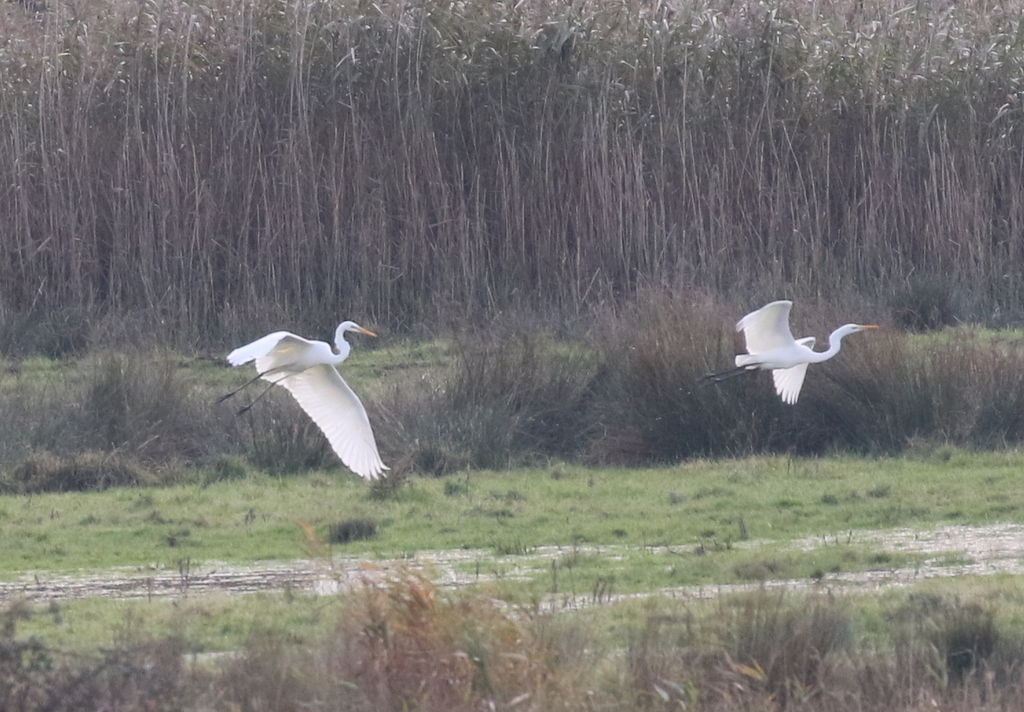
Two Marsh Harriers were in the bushes along the line of the ditch just behind and several more were in the taller trees behind the old fort. A Red Kite was perched up in the tress too, and a second one drifted across in front of the hide.
It was time to head back for lunch. We stopped in the Lookout cafe for a hot drink, and after lunch we headed out through the pines. It was a lovely sunny afternoon and there were lots of people at Holkham now, but they were mostly heading straight out to the beach. We walked west along the edge of the saltmarsh, where a large flock of Linnets wheeled round and disappeared back down into the saltmarsh vegetation.
When we got to the cordoned-off area, the Shorelarks were down at the far end. We walked round for a closer look and got them in the scope. There were six of them again, feeding in the short vegetation, looking for seeds, occasionally stopping to preen. Smart birds, their bright yellow faces were shining in the sunshine.
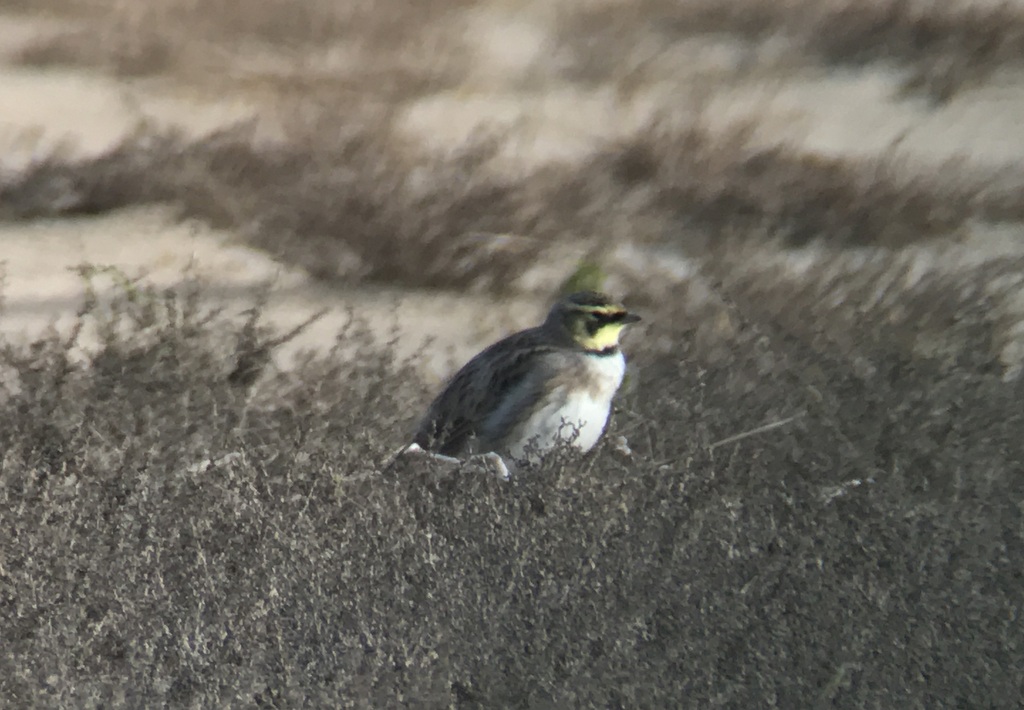
After enjoying the Shorelarks for a while, we continued on through the gap in the dunes, and stopped to scan the sea. There were lots of gulls on the beach – Black-headed, Common, Herring, and Great Black-backed Gulls. A few Sanderlings were running around on the sandbank in between them, and a few more were whirling round in a tight flock flashing white in the bright light.
There were a few Common Scoters out in the breakers, diving for shellfish. Much further out, we could see a load more, looking a bit like a big dark oil slick, possibly around a thousand birds. There were several Red-breasted Mergansers very close in, just off the beach, and a Great Crested Grebe nearby too.
Then a diver appeared – rather black and white, with a prominent white rear flank patch, it was a Black-throated Diver. It was very close in too, so we walked down teh beach to the edge of the water for a closer look. The Black-throated Diver had moved off to the left, back towards the sea, as we approached, but then came back up the channel and resurfaced right in front of us. Fantastic views, so close in – a real treat!

There were two of three Slavonian Grebes further out. They are so small, they were hard to see. They kept diving and kept disappearing behind the waves, but eventually everyone got a look at them through the scope. There was a Red-throated Diver further out too, much paler than the Black-throated Diver, with a much whiter face.
As we walked back round via the cordon, the Shorelarks were still there, but with the sun having gone behind a cloud they weren’t shining as brightly now and didn’t attract as many admiring glances as they had done on the way out. Lots of Pink-footed Geese were flying in over the pines, calling. After a quick stop to use the facilities in the Lookout cafe, as we drove back up Lady Anne’s Drive, there were now quite a few Pinkfeet on the grazing marsh nearby.
Our last stop of the day was round at Stiffkey. After all the distractions at Holkham out on the beach, we were later than we had planned and the light had already started to go. We had already missed a couple of Hen Harriers flying in, but we were pointed out a very distant Merlin, which was little more than a dark dot out on a bush on the saltmarsh.
A Peregrine flew in off the beach over the saltmarsh away to the west and disappeared off inland. Then another Merlin flew across in front of us, a male this time, grey backed. It flew quickly, dropping down low over the ground, before landing on a bush away to our left.
A ringtail Hen Harrier flew in from the west, over the saltmarsh and out to the low dune ridge out in front of us, before disappearing away behind. A short while later, presumably the same bird came back in over the saltmarsh, off to the east of us, then flew across low over the vegetation in front of us. It was getting dark now, but we could see the white patch at the base of its tail.
As the light faded, more and more Little Egrets flew past, heading in to roost. It was time for us to call it a day too. It had been another exciting one, and we still had another day to look forward to tomorrow.
















